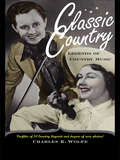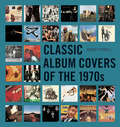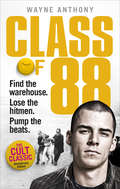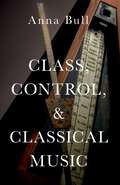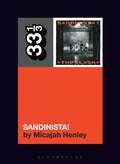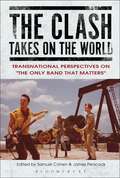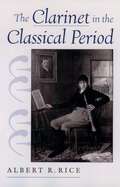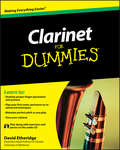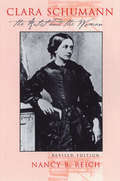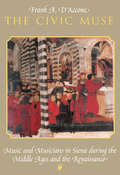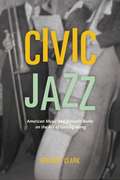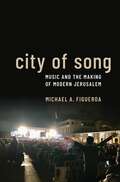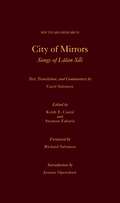- Table View
- List View
Classic Country: Legends of Country Music
by Charles K. WolfeNow for the first time, country music authority Charles K. Wolfe gathers together his profiles of 50 legends of country music, including Bill Monroe, Lefty Frizzell, and Kitty Wells.
Classic Country: Legends of Country Music
by Charles K. WolfeNow for the first time, country music authority Charles K. Wolfe gathers together his profiles of 50 legends of country music, including Bill Monroe, Lefty Frizzell, and Kitty Wells.
Classic Album Covers of the 1970s
by Aubrey PowellA stunning collection of over 200 essential and influential album covers of the decadeA visual reflection of psychedelia-influenced artwork to Punk anti- design – from Pink Floyd to the Sex PistolsIndispensable purchase for the dedicated follower of music and art
Class of '88: Find the warehouse. Lose the hitmen. Pump the beats.
by Wayne AnthonyOrganised crime puts on a smiley face.When the Summer of Love hit Britain in ’88, Wayne embraced the bright new world of dance music, MDMA and all-night celebrations. But alongside the ecstasy, his natural East End entrepreneurial instincts kicked in, and he began to organise the infamous Genesis dance parties for thousands of kids. Wayne soon became a key figure in the high octane, technicolour rave scene. But beneath the shiny, smiley surfaces, he quickly found himself in a vicious world of violence, police harassment and organised crime, for which he was totally unsuited and unprepared. He was beaten by ex-paratroopers, menaced by gangsters, kidnapped, confronted with sawn off shotguns and threatened with murder, all so Britain could party like never before.When Class of ’88 was first published, it was so popular that Foyles dedicated an entire window to the book for a month. Now, re-issued for the 30th anniversary, this is Wayne’s very lively, highly individual account of the two years he spent as an illegal party promoter, leading the rave revolution which was sweeping the UK, changing lives, music and popular culture forever.
CLASS, CONTROL, AND CLASSICAL MUSIC C
by Anna BullWhy is classical music predominantly the preserve of the white middle classes? Contemporary associations between classical music and social class remain underexplored, with classical music primarily studied as a text rather than as a practice until recent years. In order to answer this question, this book outlines a new approach for a socio-cultural analysis of classical music, asking how musical institutions, practices, and aesthetics are shaped by wider conditions of economic inequality, and how music might enable and entrench such inequalities or work against them. This approach is put into practice through a richly detailed ethnography which locates classical music within one of the cultures that produces it - middle-class English youth - and foregrounds classical music as bodily practice of control and restraint. Drawing on the author's own background as a classical musician, this closely observed account examines youth orchestra and youth choir rehearsals as a space where young people learn the unspoken rules of this culture of weighty tradition and gendered control. It highlights how the middle-classes' habitual roles - boundary drawing around their protected spaces and reproducing their privilege through education - can be traced within the everyday spaces of classical music. These practices are camouflaged, however, by the ideology of 'autonomous art' that classical music carries. Rather than solely examining the social relations around the music, the book demonstrates how this reproductive work is facilitated by its very aesthetic, of 'controlled excitement', 'getting it right', precision, and detail. This book is of particular interest at the present moment, thanks to the worldwide proliferation of El Sistema-inspired programmes which teach classical music to children in underserved areas. While such schemes demonstrate a resurgence in defending the value of classical music, there has been a lack of debate over the ways in which its socio-cultural heritage shapes its conventions today. This book locates these contestations within contemporary debates on class, gender and whiteness, making visible what is at stake in such programmes.
Class, Control, and Classical Music
by Anna BullWhy is classical music predominantly the preserve of the white middle classes? Contemporary associations between classical music and social class remain underexplored, with classical music primarily studied as a text rather than as a practice until recent years. In order to answer this question, this book outlines a new approach for a socio-cultural analysis of classical music, asking how musical institutions, practices, and aesthetics are shaped by wider conditions of economic inequality, and how music might enable and entrench such inequalities or work against them. This approach is put into practice through a richly detailed ethnography which locates classical music within one of the cultures that produces it - middle-class English youth - and foregrounds classical music as bodily practice of control and restraint. Drawing on the author's own background as a classical musician, this closely observed account examines youth orchestra and youth choir rehearsals as a space where young people learn the unspoken rules of this culture of weighty tradition and gendered control. It highlights how the middle-classes' habitual roles - boundary drawing around their protected spaces and reproducing their privilege through education - can be traced within the everyday spaces of classical music. These practices are camouflaged, however, by the ideology of 'autonomous art' that classical music carries. Rather than solely examining the social relations around the music, the book demonstrates how this reproductive work is facilitated by its very aesthetic, of 'controlled excitement', 'getting it right', precision, and detail. This book is of particular interest at the present moment, thanks to the worldwide proliferation of El Sistema-inspired programmes which teach classical music to children in underserved areas. While such schemes demonstrate a resurgence in defending the value of classical music, there has been a lack of debate over the ways in which its socio-cultural heritage shapes its conventions today. This book locates these contestations within contemporary debates on class, gender and whiteness, making visible what is at stake in such programmes.
The Clash's Sandinista! (33 1/3)
by Micajah HenleyFollowing the success of their instantly iconic double LP, London Calling, The Clash set out to do something “triply outrageous.” Named after the Nicaraguan rebels who successfully overthrew an authoritarian dictator, Sandinista! consists of 36 songs across six sides of vinyl. Produced by the band, it showcases their politics as well as their ability to adopt a multitude of genres ranging from punk, reggae, jazz, gospel, calypso, and hip hop. Free from the influence of their Machiavellian manager, Bernie Rhodes, The Clash still battled their record label to release the triple LP on their terms: three for the price of one.Despite its polarizing reception from critics at the time of its release, Sandinista! is often considered one of the greatest albums of all time. Nevertheless, critics and fans have spent over 40 years debating whether the album would be better as a 12-track LP. This book entertains that idea and considers what is lost or gained in the process. To do so, the book delves into the politics of The Clash, the spliff bunkers constructed for the production of the album, and the sacrifices made upon its release. It examines the album's 36 tracks and considers the significance of the record's dissection on behalf of fans who curate their own versions of the album in the mixtape, CD, and playlist eras.
The Clash's Sandinista! (33 1/3)
by Micajah HenleyFollowing the success of their instantly iconic double LP, London Calling, The Clash set out to do something “triply outrageous.” Named after the Nicaraguan rebels who successfully overthrew an authoritarian dictator, Sandinista! consists of 36 songs across six sides of vinyl. Produced by the band, it showcases their politics as well as their ability to adopt a multitude of genres ranging from punk, reggae, jazz, gospel, calypso, and hip hop. Free from the influence of their Machiavellian manager, Bernie Rhodes, The Clash still battled their record label to release the triple LP on their terms: three for the price of one.Despite its polarizing reception from critics at the time of its release, Sandinista! is often considered one of the greatest albums of all time. Nevertheless, critics and fans have spent over 40 years debating whether the album would be better as a 12-track LP. This book entertains that idea and considers what is lost or gained in the process. To do so, the book delves into the politics of The Clash, the spliff bunkers constructed for the production of the album, and the sacrifices made upon its release. It examines the album's 36 tracks and considers the significance of the record's dissection on behalf of fans who curate their own versions of the album in the mixtape, CD, and playlist eras.
The Clash Takes on the World: Transnational Perspectives On The Only Band That Matters
by Samuel Cohen Dr James PeacockOn their debut, The Clash famously claimed to be "bored with the USA,†? but The Clash wasn't a parochial record. Mick Jones' licks on songs such as "Hate and War†? were heavily influenced by classic American rock and roll, and the cover of Junior Murvin's reggae hit "Police and Thieves†? showed that the band's musical influences were already wide-ranging. Later albums such as Sandinista! and Combat Rock saw them experimenting with a huge range of musical genres, lyrical themes and visual aesthetics.The Clash Takes on the World explores the transnational aspects of The Clash's music, lyrics and politics, and it does so from a truly transnational perspective. It brings together literary scholars, historians, media theorists, musicologists, social activists and geographers from Europe and the US, and applies a range of critical approaches to The Clash's work in order to tackle a number of key questions: How should we interpret their negotiations with reggae music and culture? How did The Clash respond to the specific socio-political issues of their time, such as the economic recession, the Reagan-Thatcher era and burgeoning neoliberalism, and international conflicts in Nicaragua and the Falkland Islands? How did they reconcile their anti-capitalist stance with their own success and status as a global commodity? And how did their avowedly inclusive, multicultural stance, reflected in their musical diversity, square with the experience of watching the band in performance? The Clash Takes on the World is essential reading for scholars, students and general readers interested in a band whose popularity endures.
The Clash Takes on the World: Transnational Perspectives on The Only Band that Matters
by Samuel Cohen James PeacockOn their debut, The Clash famously claimed to be “bored with the USA,” but The Clash wasn't a parochial record. Mick Jones' licks on songs such as “Hate and War” were heavily influenced by classic American rock and roll, and the cover of Junior Murvin's reggae hit “Police and Thieves” showed that the band's musical influences were already wide-ranging. Later albums such as Sandinista! and Combat Rock saw them experimenting with a huge range of musical genres, lyrical themes and visual aesthetics.The Clash Takes on the World explores the transnational aspects of The Clash's music, lyrics and politics, and it does so from a truly transnational perspective. It brings together literary scholars, historians, media theorists, musicologists, social activists and geographers from Europe and the US, and applies a range of critical approaches to The Clash's work in order to tackle a number of key questions: How should we interpret their negotiations with reggae music and culture? How did The Clash respond to the specific socio-political issues of their time, such as the economic recession, the Reagan-Thatcher era and burgeoning neoliberalism, and international conflicts in Nicaragua and the Falkland Islands? How did they reconcile their anti-capitalist stance with their own success and status as a global commodity? And how did their avowedly inclusive, multicultural stance, reflected in their musical diversity, square with the experience of watching the band in performance? The Clash Takes on the World is essential reading for scholars, students and general readers interested in a band whose popularity endures.
The Clarinet in the Classical Period
by Albert R. RiceA comprehensive study of the clarinet in use through the classical period, 1760 to 1830, a period of intensive musical experimentation. The book provides a detailed review and analysis of construction, design, materials, and makers of clarinets. Rice also explores how clarinet construction and performance practice developed in tandem with the musical styles of the period.
The Clarinet in the Classical Period
by Albert R. RiceA comprehensive study of the clarinet in use through the classical period, 1760 to 1830, a period of intensive musical experimentation. The book provides a detailed review and analysis of construction, design, materials, and makers of clarinets. Rice also explores how clarinet construction and performance practice developed in tandem with the musical styles of the period.
Clarinet For Dummies
by David EtheridgeMaster the most popular woodwind Want to play the clarinet? No problem! This hands-on guide teaches you all the fundamental techniques you need to play this popular woodwind alone or in a group setting. Clarinet For Dummies gives you the ideal introduction to play clarinet. You?ll begin by learning how to properly hold a clarinet and move on to getting a consistent sound, reading music, and playing songs in a variety of styles, including classical, pop, and jazz. Step-by-step instruction on finger placement, posture, and basic up-keep for the instrument Tips on how to buy or rent a clarinet Accompanying CD offers play-along recordings of every exercise featured in the book Whether you?ve never held a clarinet or are looking to brush up on skills from your youth, Clarinet For Dummies is packed with friendly, easy-to-follow instructions to have you playing this versatile instrument with ease! Note: CD-ROM/DVD and other supplementary materials are not included as part of eBook file.
Clarinet For Dummies
by David EtheridgeMaster the most popular woodwind Want to play the clarinet? No problem! This hands-on guide teaches you all the fundamental techniques you need to play this popular woodwind alone or in a group setting. Clarinet For Dummies gives you the ideal introduction to play clarinet. You?ll begin by learning how to properly hold a clarinet and move on to getting a consistent sound, reading music, and playing songs in a variety of styles, including classical, pop, and jazz. Step-by-step instruction on finger placement, posture, and basic up-keep for the instrument Tips on how to buy or rent a clarinet Accompanying CD offers play-along recordings of every exercise featured in the book Whether you?ve never held a clarinet or are looking to brush up on skills from your youth, Clarinet For Dummies is packed with friendly, easy-to-follow instructions to have you playing this versatile instrument with ease! Note: CD-ROM/DVD and other supplementary materials are not included as part of eBook file.
Clara Schumann: The Artist and the Woman (Dover Music For Piano Ser.)
by Nancy ReichThis absorbing and award-winning biography tells the story of the tragedies and triumphs of Clara Wieck Schumann (1819–1896), a musician of remarkable achievements. At once artist, composer, editor, teacher, wife, and mother of eight children, she was an important force in the musical world of her time. To show how Schumann surmounted the obstacles facing female artists in the nineteenth century, Nancy B. Reich has drawn on previously unexplored primary sources: unpublished diaries, letters, and family papers, as well as concert programs. Going beyond the familiar legends of the Schumann literature, she applies the tools of musicological scholarship and the insights of psychology to provide a new, full-scale portrait.The book is divided into two parts. In Part One, Reich follows Clara Schumann's life from her early years as a child prodigy through her marriage to Robert Schumann and into the forty years after his death, when she established and maintained an extraordinary European career while supporting and supervising a household and seven children. Part Two covers four major themes in Schumann's life: her relationship with Johannes Brahms and other friends and contemporaries; her creative work; her life on the concert stage; and her success as a teacher.Throughout, excerpts from diaries and letters in Reich's own translations clear up misconceptions about her life and achievements and her partnership with Robert Schumann. Highlighting aspects of Clara Schumann's personality and character that have been neglected by earlier biographers, this candid and eminently readable account adds appreciably to our understanding of a fascinating artist and woman.For this revised edition, Reich has added several photographs and updated the text to include recent discoveries. She has also prepared a Catalogue of Works that includes all of Clara Schumann's known published and unpublished compositions and works she edited, as well as descriptions of the autographs, the first editions, the modern editions, and recent literature on each piece. The Catalogue also notes Schumann's performances of her own music and provides pertinent quotations from letters, diaries, and contemporary reviews.
The Civic Muse: Music and Musicians in Siena during the Middle Ages and the Renaissance
by Frank A. D'AcconeSiena, blessed with neither the aristocratic nor the ecclesiastical patronage enjoyed by music in other northern Italian centers like Florence, nevertheless attracted first-rate composers and performers from all over Europe. As Frank A. D'Accone shows in this scrupulously documented study, policies developed by the town to favor the common good formed the basis of Siena's ambitious musical programs. Based on decades of research in the town's archives, D'Accone's The Civic Muse brilliantly illuminates both the sacred and the secular aspects of more than three centuries of music and music-making in Siena. After detailing the history of music and liturgy at Siena's famous cathedral and of civic music at the Palazzo Pubblico, D'Accone describes the crucial role that music played in the daily life of the town, from public festivities for foreign dignitaries to private musical instruction. Putting Siena squarely on the Renaissance musical map, D'Accone's monumental study will interest both musicologists and historians of the Italian Renaissance.
Civic Jazz: American Music and Kenneth Burke on the Art of Getting Along
by Gregory ClarkJazz is born of collaboration, improvisation, and listening. In much the same way, the American democratic experience is rooted in the interaction of individuals. It is these two seemingly disparate, but ultimately thoroughly American, conceits that Gregory Clark examines in Civic Jazz. Melding Kenneth Burke’s concept of rhetorical communication and jazz music’s aesthetic encounters with a rigorous sort of democracy, this book weaves an innovative argument about how individuals can preserve and improve civic life in a democratic culture. Jazz music, Clark argues, demonstrates how this aesthetic rhetoric of identification can bind people together through their shared experience in a common project. While such shared experience does not demand agreement—indeed, it often has an air of competition—it does align people in practical effort and purpose. Similarly, Clark shows, Burke considered Americans inhabitants of a persistently rhetorical situation, in which each must choose constantly to identify with some and separate from others. Thought-provoking and path-breaking, Clark’s harmonic mashup of music and rhetoric will appeal to scholars across disciplines as diverse as political science, performance studies, musicology, and literary criticism.
Civic Jazz: American Music and Kenneth Burke on the Art of Getting Along
by Gregory ClarkJazz is born of collaboration, improvisation, and listening. In much the same way, the American democratic experience is rooted in the interaction of individuals. It is these two seemingly disparate, but ultimately thoroughly American, conceits that Gregory Clark examines in Civic Jazz. Melding Kenneth Burke’s concept of rhetorical communication and jazz music’s aesthetic encounters with a rigorous sort of democracy, this book weaves an innovative argument about how individuals can preserve and improve civic life in a democratic culture. Jazz music, Clark argues, demonstrates how this aesthetic rhetoric of identification can bind people together through their shared experience in a common project. While such shared experience does not demand agreement—indeed, it often has an air of competition—it does align people in practical effort and purpose. Similarly, Clark shows, Burke considered Americans inhabitants of a persistently rhetorical situation, in which each must choose constantly to identify with some and separate from others. Thought-provoking and path-breaking, Clark’s harmonic mashup of music and rhetoric will appeal to scholars across disciplines as diverse as political science, performance studies, musicology, and literary criticism.
Civic Jazz: American Music and Kenneth Burke on the Art of Getting Along
by Gregory ClarkJazz is born of collaboration, improvisation, and listening. In much the same way, the American democratic experience is rooted in the interaction of individuals. It is these two seemingly disparate, but ultimately thoroughly American, conceits that Gregory Clark examines in Civic Jazz. Melding Kenneth Burke’s concept of rhetorical communication and jazz music’s aesthetic encounters with a rigorous sort of democracy, this book weaves an innovative argument about how individuals can preserve and improve civic life in a democratic culture. Jazz music, Clark argues, demonstrates how this aesthetic rhetoric of identification can bind people together through their shared experience in a common project. While such shared experience does not demand agreement—indeed, it often has an air of competition—it does align people in practical effort and purpose. Similarly, Clark shows, Burke considered Americans inhabitants of a persistently rhetorical situation, in which each must choose constantly to identify with some and separate from others. Thought-provoking and path-breaking, Clark’s harmonic mashup of music and rhetoric will appeal to scholars across disciplines as diverse as political science, performance studies, musicology, and literary criticism.
Civic Jazz: American Music and Kenneth Burke on the Art of Getting Along
by Gregory ClarkJazz is born of collaboration, improvisation, and listening. In much the same way, the American democratic experience is rooted in the interaction of individuals. It is these two seemingly disparate, but ultimately thoroughly American, conceits that Gregory Clark examines in Civic Jazz. Melding Kenneth Burke’s concept of rhetorical communication and jazz music’s aesthetic encounters with a rigorous sort of democracy, this book weaves an innovative argument about how individuals can preserve and improve civic life in a democratic culture. Jazz music, Clark argues, demonstrates how this aesthetic rhetoric of identification can bind people together through their shared experience in a common project. While such shared experience does not demand agreement—indeed, it often has an air of competition—it does align people in practical effort and purpose. Similarly, Clark shows, Burke considered Americans inhabitants of a persistently rhetorical situation, in which each must choose constantly to identify with some and separate from others. Thought-provoking and path-breaking, Clark’s harmonic mashup of music and rhetoric will appeal to scholars across disciplines as diverse as political science, performance studies, musicology, and literary criticism.
Civic Jazz: American Music and Kenneth Burke on the Art of Getting Along
by Gregory ClarkJazz is born of collaboration, improvisation, and listening. In much the same way, the American democratic experience is rooted in the interaction of individuals. It is these two seemingly disparate, but ultimately thoroughly American, conceits that Gregory Clark examines in Civic Jazz. Melding Kenneth Burke’s concept of rhetorical communication and jazz music’s aesthetic encounters with a rigorous sort of democracy, this book weaves an innovative argument about how individuals can preserve and improve civic life in a democratic culture. Jazz music, Clark argues, demonstrates how this aesthetic rhetoric of identification can bind people together through their shared experience in a common project. While such shared experience does not demand agreement—indeed, it often has an air of competition—it does align people in practical effort and purpose. Similarly, Clark shows, Burke considered Americans inhabitants of a persistently rhetorical situation, in which each must choose constantly to identify with some and separate from others. Thought-provoking and path-breaking, Clark’s harmonic mashup of music and rhetoric will appeal to scholars across disciplines as diverse as political science, performance studies, musicology, and literary criticism.
Civic Jazz: American Music and Kenneth Burke on the Art of Getting Along
by Gregory ClarkJazz is born of collaboration, improvisation, and listening. In much the same way, the American democratic experience is rooted in the interaction of individuals. It is these two seemingly disparate, but ultimately thoroughly American, conceits that Gregory Clark examines in Civic Jazz. Melding Kenneth Burke’s concept of rhetorical communication and jazz music’s aesthetic encounters with a rigorous sort of democracy, this book weaves an innovative argument about how individuals can preserve and improve civic life in a democratic culture. Jazz music, Clark argues, demonstrates how this aesthetic rhetoric of identification can bind people together through their shared experience in a common project. While such shared experience does not demand agreement—indeed, it often has an air of competition—it does align people in practical effort and purpose. Similarly, Clark shows, Burke considered Americans inhabitants of a persistently rhetorical situation, in which each must choose constantly to identify with some and separate from others. Thought-provoking and path-breaking, Clark’s harmonic mashup of music and rhetoric will appeal to scholars across disciplines as diverse as political science, performance studies, musicology, and literary criticism.
City of Song: Music and the Making of Modern Jerusalem
by Michael A. FigueroaModern Jerusalem, a city central to Jewish, Muslim, and Christian religious imaginaries and the political epicenter of the Israeli-Palestinian crisis, is to put it mildly a highly contested space. More surprising, perhaps, is that its musical landscape not only reflects these rifts but also helped to define them as the ancient city transitioned to modernity during the twentieth century. In City of Song: Music and the Making of Modern Jerusalem, author Michael A. Figueroa argues that musical renderings of Jerusalem have been critical to the formation of Israeli political consciousness. The book demonstrates how Israeli songwriters helped to shape their public's territorial imagination-- creating images of a city at once heavenly and earthly, that dwells in longing, that must not be forgotten, that compels one to bereave the dead, that represents the fulfilment of prophecy, and that is the site of immense cultural diversity. The dynamic history of its representation in lyrics and music helps dispel any notion that the Israeli-Palestinian crisis is timeless, intractable, and based on static, essential identities; while there are continuities across historical divides, radical change constantly transpires. City of Song combines analyses of musical meaning, political discourse, and public performance over the long twentieth century (1880s-2010) to reveal how the Israeli-Palestinian crisis' territorial fixation on Jerusalem has been constructed, historically contingent, and subject to artistic intervention in modernity. Through a musical history of Jerusalem, Figueroa introduces a novel, humanities-centered approach to one of the world's most contested cities, and one of the defining cultural and political questions of our era.
City of Song: Music and the Making of Modern Jerusalem
by Michael A. FigueroaModern Jerusalem, a city central to Jewish, Muslim, and Christian religious imaginaries and the political epicenter of the Israeli-Palestinian crisis, is to put it mildly a highly contested space. More surprising, perhaps, is that its musical landscape not only reflects these rifts but also helped to define them as the ancient city transitioned to modernity during the twentieth century. In City of Song: Music and the Making of Modern Jerusalem, author Michael A. Figueroa argues that musical renderings of Jerusalem have been critical to the formation of Israeli political consciousness. The book demonstrates how Israeli songwriters helped to shape their public's territorial imagination-- creating images of a city at once heavenly and earthly, that dwells in longing, that must not be forgotten, that compels one to bereave the dead, that represents the fulfilment of prophecy, and that is the site of immense cultural diversity. The dynamic history of its representation in lyrics and music helps dispel any notion that the Israeli-Palestinian crisis is timeless, intractable, and based on static, essential identities; while there are continuities across historical divides, radical change constantly transpires. City of Song combines analyses of musical meaning, political discourse, and public performance over the long twentieth century (1880s-2010) to reveal how the Israeli-Palestinian crisis' territorial fixation on Jerusalem has been constructed, historically contingent, and subject to artistic intervention in modernity. Through a musical history of Jerusalem, Figueroa introduces a novel, humanities-centered approach to one of the world's most contested cities, and one of the defining cultural and political questions of our era.
CITY OF MIRRORS C: Songs of Lalan Sai (South Asia Research)
Carol Salomon dedicated over thirty years of her life to researching, translating, and annotating this compilation of songs by the Bengali poet and mystical philosopher Lalan Sai (popularly transliterated as Lalon) who lived in the village of Cheuriya in Bengal in the latter half of the nineteenth century. One major objective of his lyrical riddles was to challenge the restrictions of cultural, political, and sexual identity, and his songs accordingly express a longing to understand humanity, its duties, and its ultimate destiny. His songs also contain thinly veiled references to esoteric yogic practices (sadhana), including body-centered Hathayogic techniques that are related to those found in Buddhist, Kaula, Natha, and Sufi medieval tantric literature. Dr. Salomon's translation of the work is the first dedicated English translation of Lalan's songs to closely follow the Bangla text, with all of its dialectical variations, and is here produced alongside the original text. Although her untimely death left her work unpublished, the editors have worked diligently to reconstruct her translations from her surviving printed and handwritten manuscripts. The result is a finished product that can finally share her groundbreaking scholarship on Baul traditions with the world.
